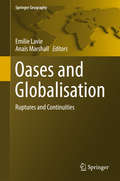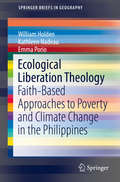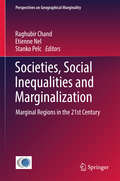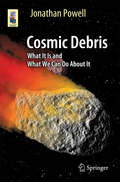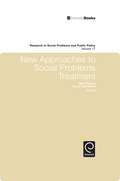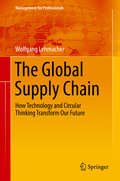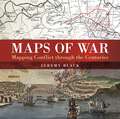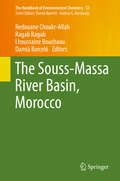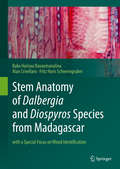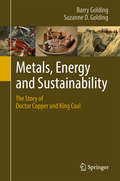- Table View
- List View
Gravity Inversion and Integration: Theory and Applications in Geodesy and Geophysics
by Lars E. Sjöberg Mohammad BagherbandiThis book contains theory and applications of gravity both for physical geodesy and geophysics. It identifies classical and modern topics for studying the Earth. Worked-out examples illustrate basic but important concepts of the Earth’s gravity field. In addition, coverage details the Geodetic Reference System 1980, a versatile tool in most applications of gravity data.The authors first introduce the necessary mathematics. They then review classic physical geodesy, including its integral formulas, height systems and their determinations. The next chapter presents modern physical geodesy starting with the original concepts of M.S. Molodensky. A major part of this chapter is a variety of modifying Stokes’ formula for geoid computation by combining terrestrial gravity data and an Earth Gravitational Model.Coverage continues with a discussion that compares today’s methods for modifying Stokes’ formulas for geoid and quasigeoid determination, a description of several modern tools in physical geodesy, and a review of methods for gravity inversion as well as analyses for temporal changes of the gravity field.This book aims to broaden the view of scientists and students in geodesy and geophysics. With a focus on theory, it provides basic and some in-depth knowledge about the field from a geodesist’s perspective.
Renewable Energy Clusters: Recurring Barriers to Cluster Development in Eleven Countries (Innovation, Technology, and Knowledge Management)
by Gudrun Jaegersberg Jenny UreTaking eleven countries in Europe, Canada, South Africa, America, Latin America and Australia, this book discusses recurring barriers to cluster development in the renewable energy sector. The authors look at the real-world dynamics and tensions between stakeholders on the ground, with a particular focus on the relationships between SMEs and other actors. This trans-regional study is unique in its scale and scope, drawing on a decade of field research to show how by learning from the successes and failures of other clusters, costs and risk can be reduced. The book fills a significant gap in the literature for policymakers, managers and economic developers in a key market.
Directed Polymers in Random Environments: École d'Été de Probabilités de Saint-Flour XLVI – 2016 (Lecture Notes in Mathematics #2175)
by Francis CometsAnalyzing the phase transition from diffusive to localized behavior in a model of directed polymers in a random environment, this volume places particular emphasis on the localization phenomenon. The main questionis: What does the path of a random walk look like if rewards and penalties are spatially randomly distributed?This model, which provides a simplified version of stretched elastic chains pinned by random impurities, has attracted much research activity, but it (and its relatives) still holds many secrets, especially in high dimensions. It has non-gaussian scaling limits and it belongs to the so-called KPZ universality class when the space is one-dimensional. Adopting a Gibbsian approach, using general and powerful tools from probability theory, the discrete model is studied in full generality. Presenting the state-of-the art from different perspectives, and written in the form of a first course on the subject, this monograph is aimed at researchers in probability or statistical physics, but is also accessible to masters and Ph.D. students.
Freezing Colloids: Applications in Materials Science, Life Science, Earth Science, Food Science, and Engineering (Engineering Materials and Processes)
by Sylvain DevilleThis book presents a comprehensive overview of the freezing of colloidal suspensions and explores cutting-edge research in the field. It is the first book to deal with this phenomenon from a multidisciplinary perspective, and examines the various occurrences, their technological uses, the fundamental phenomena, and the different modeling approaches. Its chapters integrate input from fields as diverse as materials science, physics, biology, mathematics, geophysics, and food science, and therefore provide an excellent point of departure for anyone interested in the topic. The main content is supplemented by a wealth of figures and illustrations to elucidate the concepts presented, and includes a final chapter providing advice for those starting out in the field. As such, the book provides an invaluable resource for materials scientists, physicists, biologists, and mathematicians, and will also benefit food engineers, civil engineers, and materials processing professionals.
Regional Research Frontiers - Vol. 1: Innovations, Regional Growth and Migration (Advances in Spatial Science)
by Randall Jackson Peter SchaefferThis volume focuses on frontiers in regional research and identifies trends and future developments in the areas of innovation, regional growth and migration. It also addresses topics such as mobility, regional forecasting, and regional policy, and includes expert contributions on disasters, resilience, and sustainability. Building on recent methodological and modelling advances, as well as on extensive policy-analysis experience, top international regional scientists identify and evaluate emerging new conceptual and methodological trends and directions in regional research. This book will appeal to a wide readership, from regional scientists and economists to geographers, quantitatively oriented regional planners and other related disciplines. It offers a source of relevant information for academic researchers and policy analysts in government, and is also suitable for advanced teaching courses on regional and spatial science, economics and political science.
Glaciers of Georgia (Geography of the Physical Environment)
by Levan TielidzeThis book gives the most detailed and comprehensive insights into the morphology, morphometry and dynamics of glaciers in the Georgian Caucasus region up to date. It examines the variability of valley glaciers after the Little Ice Age maximum and identifies glacial dynamics during historical periods. The reconstruction of glaciation in the Late Pleistocene and Holocene was conducted based on long lasting detailed glacial-geomorphological observations by the author. It further analyses moraine structures, river terraces, geodynamics of the relief, and snow and firn line locations derived from field surveys in most glacier basins in the southern and northern slopes of the Georgian Caucasus. A whole set of methodological approaches was applied including remote sensing and GIS, glacio-geomorphological, cartographical, aerial image processing and petrographic methods, unveiling accurate information about glaciers difficult to access, e.g. in the Abkhazeti and Tskhinvali regions. The book provides a full database of Georgia’s modern glaciation and displays a set of compiled maps of the distribution of the Late Pleistocene glaciation of the Georgian Caucasus.
Regional Research Frontiers - Vol. 2: Methodological Advances, Regional Systems Modeling and Open Sciences (Advances in Spatial Science)
by Randall Jackson Peter SchaefferThis is the second volume in a two-part series on frontiers in regional research. It identifies methodological advances as well as trends and future developments in regional systems modelling and open science. Building on recent methodological and modelling advances, as well as on extensive policy-analysis experience, top international regional scientists identify and evaluate emerging new conceptual and methodological trends and directions in regional research. Topics such as dynamic interindustry modelling, computable general equilibrium models, exploratory spatial data analysis, geographic information science, spatial econometrics and other advanced methods are the central focus of this book. The volume provides insights into the latest developments in object orientation, open source, and workflow systems, all in support of open science. It will appeal to a wide readership, from regional scientists and economists to geographers, quantitatively oriented regional planners and other related disciplines. It offers a source of relevant information for academic researchers and policy analysts in government, and is also suitable for advanced teaching courses on regional and spatial science, economics and political science.
Oases and Globalization: Ruptures and Continuities (Springer Geography)
by Emilie Lavie Anaïs MarshallThis book is a reference work about the study of oases in the context of globalization. It is based on selected papers presented at the international colloquium entitled Oases in the Globalization, Ruptures and Continuities in Paris (December 16-17th, 2013). The main issue was to understand how oases have been excluded from or included into the process of globalization.In this context, the present book proposes firstly a discussion about the definition(s) of oasis and secondly several case studies analysing socio-spatial mutations in the oasis structure. The third part deals with the compelling globalization at different spatial scales, using two entries: the water management and local impacts of external control.
Ecological Liberation Theology: Faith-Based Approaches to Poverty and Climate Change in the Philippines (SpringerBriefs in Geography)
by William Holden Kathleen Nadeau Emma PorioClimate change-related effects and aftermaths of natural disasters, such as Typhoon Haiyan in the Philippines, have wreaked havoc on local peoples’ lives and livelihoods, especially in impoverished coastal communities. This book looks at local-level responses to the effects of climate change from the perspective of ecological theology and feminism, which provides a solution-based and gender-equitable approach to some of the problems of climate change. It examines how local social and religious action workers are partnering with local communities to transform and reconstruct their lives and livelihoods in the 21st century.
Creep in Ceramics (Solid Mechanics and Its Applications #241)
by Joshua PellegThis book focuses on Creep in Ceramics. The book consists of two parts. In part A general knowledge of creep in ceramics is considered, while part B specifies creep in technologically important ceramics, namely creep in oxide ceramics, carnides and nitrides. While covering all relevant information regarding raw materials and characterization of creep in ceramics, the book also summarizes most recent innovations and developments in this field as a result of extensive literature search.
Solar Energetic Particles: A Modern Primer on Understanding Sources, Acceleration and Propagation (Lecture Notes in Physics #932)
by Donald V. ReamesThis concise primer introduces the non-specialist reader to the physics of solar energetic particles (SEP) and systematically reviews the evidence for the two main mechanisms which lead to the so-called impulsive and gradual SEP events.More specifically, the timing of the onsets, the longitude distributions, the high-energy spectral shapes, the correlations with other solar phenomena (e.g. coronal mass ejections), as well as the all-important elemental and isotopic abundances of SEPs are investigated. Impulsive SEP events are related to magnetic reconnection in solar flares and jets. The concept of shock acceleration by scattering on self-amplified Alfvén waves is introduced, as is the evidence of reacceleration of impulsive-SEP material in the seed population accessed by the shocks in gradual events. The text then develops processes of transport of ions out to an observer. Finally, a new technique to determine the source plasma temperature in both impulsive and gradual events is demonstrated.Last but not least the role of SEP events as a radiation hazard in space is mentioned and a short discussion of the nature of the main particle telescope designs that have contributed to most of the SEP measurements is given.
The Electron Mass and Calcium Isotope Shifts: High-Precision Measurements of Bound-Electron g-Factors of Highly Charged Ions (Springer Theses)
by Florian Köhler-LangesThis thesis presents the first isotope-shift measurement of bound-electron g-factors of highly charged ions and determines the most precise value of the electron mass in atomic mass units, which exceeds the value in the literature by a factor of 13. As the lightest fundamental massive particle, the electron is one of nature’s few central building blocks. A precise knowledge of its intrinsic properties, such as its mass, is mandatory for the most accurate tests in physics - the Quantum Electrodynamics tests that describe one of the four established fundamental interactions in the universe. The underlying measurement principle combines a high-precision measurement of the Larmor-to-cyclotron frequency ratio on a single hydrogen-like carbon ion studied in a Penning trap with very accurate calculations of the so-called bound-electron g-factor. For the isotope-shift measurement, the bound-electron g-factors of two lithium-like calcium isotopes have been measured with relative uncertainties of a few 10^{-10}, constituting an as yet unrivaled level of precision for lithium-like ions.
Societies, Social Inequalities and Marginalization: Marginal Regions in the 21st Century (Perspectives on Geographical Marginality #2)
by Raghubir Chand Etienne Nel Stanko PelcThis book provides an overview of marginality or marginalization, as a concept, characterizing a situation of impediments – social, political, economic, physical, and environmental – that impact the abilities of many people and societies to improve their human condition. It examines a wide range of examples and viewpoints of societies struggling with poverty, social inequality and marginalization.Though the book will be especially interesting for those looking for insights into the situation and position of ethnic groups living in harsh mountainous conditions in the Himalayan region, examples from other parts of the world such as Kyrgyzstan, Israel, Switzerland and Finland provide an opportunity for comparison of marginality and marginalization from around the world. Also addressed are issues such as livelihood, outmigration and environmental threats, taking into account the conditions, scale and perspective of observation. Throughout the text, particular attention is given to the context and concept of ‘marginalization’, which sadly remains a persistent reality of human life. It is in this context that this book seeks to advance our global understanding of what marginalization is, how it is manifested and what causes it, while also proposing remedial strategies.
Cosmic Debris: What It Is and What We Can Do About It (Astronomers' Universe)
by Jonathan PowellThis book examines the mysterious and the well-studied debris in Earth’s crowded neighborhood. From orbiting comets to the workings of the Asteroid Belt, and from meteor showers to our home-grown network of orbiting satellites, the full diversity of space objects and the debris they create is explored. Powell also discusses some of the current research techniques used to find potentially harmful rogue elements, with an emphasis on keeping watch for any objects that may intersect Earth’s orbit. Such bodies also impact other worlds, and much has been learned from observing these encounters.The information in this book is intended to foster thought about the universe in which we live, but without overloading its readers with numbers and lecture-room analysis. Like a good thriller, it allows its readers to pace themselves with the story and, by the end, encourages them to draw their own conclusions.
New Approaches to Social Problems Treatment (Research in Social Problems and Public Policy #17)
by Stacy Lee Burns Mark PeyrotThis volume examines diverse developments in the evolution of public policy institutions for remedying social problems. The collected chapters address the transformation of social problems, social problems work, and social problems solutions in the context of criminal justice, mental health, and community institutions (schools) in contemporary society. These diverse settings and institutions collectively reflect a trend toward the use of various 'treatment' initiatives within formal disciplinary systems and as part of legalistic social control strategies. Although all of the remedial approaches considered are 'new' in the sense of being recent innovations, many are only the most recent in a long sequence of policy initiatives. The contributors to the collection demonstrate that recent transformations in remedial approaches to social problems and the challenges faced by such policy initiatives are as much a function of what has come before as they are of their own inherent features.
Karst Groundwater Contamination and Public Health: Beyond Case Studies (Advances in Karst Science)
by William B. White Janet S. Herman Ellen K. Herman Marian RutiglianoThis book sheds new light on contaminant transport in karst aquifers and the public health implications of contaminated karst groundwater. The papers included were presented at a conference held in early 2016 in San Juan, Puerto Rico, and range from lengthy reviews on contaminant transport mechanisms to short articles summarizing research findings. The conference addressed a variety of topics, such as contamination sources, the hydrogeology of contaminant transport, the storage and release of contaminants, and the health impacts as well as the epidemiology of contaminated water supplies drawn from karst aquifers, and gathered perspectives from experts in different disciplines, including hydrogeologists and public health specialists. Although there is a wealth of literature on specific instances of karst groundwater contamination, this book offers an integrated conceptual framework for the public health impacts of karst groundwater, making it a valuable resource for a broad interdisciplinary readership.
The Global Supply Chain: How Technology and Circular Thinking Transform Our Future (Management for Professionals)
by Wolfgang LehmacherThis book provides readers an in-depth understanding of the inner mechanisms and principles of the global supply chain. Authored by the Head of Supply Chain and Transport Industries at the World Economic Forum, it draws on a wealth of operational and managerial expertise in the global supply chain industry that drive the world’s economies. The book analyzes the importance and impact of globally networked sourcing, production and distribution, and presents detailed information on the opportunities, limitations and challenges of linear value and supply chain systems. Building on a series of recent industry cases and with a focus on the latest developments in actual business processes and models, it reveals how the transformation toward circular supply chains and regenerative resource management forms the basis for success and sustainability in business.“The book brings together technical, social, political, and geographical trends, suggesting how supply chain management can lead the quest for many of the world’s most pressing challenges.” Yossi Sheffi, Professor of Engineering, MIT, Head, MIT Center for Transportation and Logistics“This book provides an essential roadmap, guiding the reader easily through complex developments and concepts.” John Manners-Bell, CEO Transport Intelligence and Honorary Visiting Professor, Guildhall Business School, London “With strategic foresight, Lehmacher develops a vision of a circular economy within which consumer, manufacturer and logistics companies assume collective responsibility for sustainable value creation.” Alfred Talke, Group Managing Director ALFRED TALKE Logistic Services “Those who are active in logistics and supply chain management, in practice or academia, will discover a fresh view on the whole field of activity beyond the day-to-day-business.” Prof. Dr.-Ing. Thomas Wimmer, Chairman of the Executive Board, BVL International
Maps of War: Mapping Conflict Through the Centuries
by Jeremy BlackThere is little documented mapping of conflict prior to the Renaissance period, but, from the 17th century onwards, military commanders and strategists began to document the wars in which they were involved and later, to use mapping to actually plan the progress of a conflict. Using contemporary maps, this sumptuous new volume covers the history of the mapping of war on land and shows the way in which maps provide a guide to the history of war. Content includes:The beginnings of military mapping up to 1600 including the impact of printing and the introduction of gunpowderThe seventeenth century: The focus is on maps to illustrate war, rather than as a planning tool and the chapter considers the particular significance of maps of fortifications.The eighteenth century: The growing need for maps on a world scale reflects the spread of European power and of transoceanic conflict between Europeans. This chapter focuses in particular on the American War of Independence.The nineteenth century: Key developments included contouring and the creation of military surveying. Subjects include the Napoleonic Wars and the American Civil WarThe twentieth century including extended features on the First and Second World Wars including maps showing trench warfare and aerial reconnaissance. Much of the chapter focuses on the period from 1945 to the present day including special sections on the Vietnam War and the Gulf Wars.
The Souss‐Massa River Basin, Morocco (The Handbook of Environmental Chemistry #53)
by Redouane Choukr Allah Ragab Ragab Lhoussaine Bouchaou Damià BarcelóThis volume offers a comprehensive analysis of the water resources in the Souss-Massa river basin in southwestern Morocco and provides novel water-management approaches to narrow the gap between supply and demand for water. It evaluates conventional water resources−surface water and groundwater−and discusses in detail rainfall harvesting into dams along the Souss and Massa wadis. Further, it explores topics including the geology of the aquifer; the risk of over exploitation; alternative water resources, such as desalinated seawater and treated domestic wastewater, as well as management approaches like Data Development Analysis and the SALTMED model. With a focus on linking scientific research to practical applications and the demands of agriculture and associated agro-industry, urbanization and tourism, which compete for the limited water resources, the book appeals to environmental scientists, geologists, engineers and environmental managers.
Stem Anatomy of Dalbergia and Diospyros Species from Madagascar: with a Special Focus on Wood Identification
by Bako Harisoa Ravaomanalina Alan Crivellaro Fritz Hans SchweingruberThis atlas offers anatomical descriptions of 19 Dalbergia and 31 Diospyros species, most of them endemic to Madagascar. Each species is illustrated with color micrographs of double-stained sections through the xylem, bark, and pith of stems, branches, and twigs. Further, a photograph of each plant and information on its height, DBH, habit, and geographical and elevational distribution in Madagascar are included. Dalbergia and Diospyros species provide highly-priced woods, which are intensively traded across the world and therefore highly endangered by illegal trade and harvesting. This book represents a response to the action plan for Diospyros and Dalbergia species regarding the establishment of a reference collection and reliable identification system for species listed by CITES, the Convention on International Trade in Endangered Species of Wild Fauna and Flora. Bringing together a wealth of material recently collected in different biogeographical regions of Madagascar and identified by the Missouri Botanical Garden, the book will appeal to plant scientists, taxonomists and practitioners involved in wood identification, and will help to safeguard the legacy of precious wood trading through proper identification.
An Introduction to Modeling Neuronal Dynamics (Texts in Applied Mathematics #66)
by Christoph BörgersThis book is intended as a text for a one-semester course on Mathematical and Computational Neuroscience for upper-level undergraduate and beginning graduate students of mathematics, the natural sciences, engineering, or computer science. An undergraduate introduction to differential equations is more than enough mathematical background. Only a slim, high school-level background in physics is assumed, and none in biology. Topics include models of individual nerve cells and their dynamics, models of networks of neurons coupled by synapses and gap junctions, origins and functions of population rhythms in neuronal networks, and models of synaptic plasticity.An extensive online collection of Matlab programs generating the figures accompanies the book.
Metals, Energy and Sustainability: The Story of Doctor Copper and King Coal
by Barry Golding Suzanne D. GoldingThis book explains how and where copper and fossil fuels were formed and the likely future for the extraction of copper and coal. The colourful chronology of our efforts to extract metals from minerals and energy from fossil fuels is presented from earliest times until the present day. The difficult concept of human sustainability is examined in the context of continually decreasing real prices of energy and metals. This book integrates the latest findings on our historic use of technology to continually produce cheaper metals even though ore grades have been decreasing. Furthermore, it shows that the rate of technological improvement must increase if metals are to be produced even more cheaply in the future.
Central Asia and the Silk Road: Economic Rise and Decline over Several Millennia (Studies in Economic History)
by Stephan BarisitzThis book offers a comprehensive overview of the pre-modern economic history of Central Asia and the Silk Road, covering several millennia. By analyzing an abundance of sources and materials, it illustrates the repeated economic heydays of the Silk Road, during which it linked the Orient and Occident for many centuries. Nomadic steppe empires frequently dominated Central Asia, molded its economy and influenced trade along the Silk Road. The book assesses the causes and effects of the wide-ranging overland trade booms, while also discussing various internal and external factors that led to the gradual economic decline of Central Asia and eventual demise of the Silk Road. Lastly, it explains how the economic decline gave rise to Chinese and Russian colonialism in the 18th and 19th centuries. Detailed information, e.g. on the Silk Road’s trajectories in various epochs, is offered in the form of numerous newly drafted maps.
Cadastre: Geo-Information Innovations in Land Administration
by Tahsin Yomralioglu John McLaughlinThis book highlights the latest improvements in cadastre with examples and case studies from various parts of the world. Authors from different continents, in association with national and international organizations and societies, present the most comprehensive forum to date for cadastre, offering a broad overview of land administration and contemporary perspectives on current research and developments, including surveying, land management, remote sensing and geo-information sciences. Cadastre is a universal concept and is defined as “the work of officially mapping and systemically registering the areas, borders and values of all kinds of land and property”. It is normally a parcel-based and up-to-date land information system containing a record of interests in land with rights, restrictions and responsibilities. It may be established for fiscal and legal purposes, to assist in management for better planning and other administrative purposes, and to enable sustainable development and environmental protection. As such, “cadastre” is an important public inventory documenting the records of ownership, bordering and responsibility regarding the land with “title deeds” to parcels and answering the questions of “whose land, where and how much”.The materials included in the book can support courses at universities and related training institutions worldwide, and will greatly improve readers’ understanding of the scholarly fields involved in cadastre: land registration and management, surveying and mapping, and geo-information management, land governance, land taxation and public administration etc.
The Sea Floor: An Introduction to Marine Geology (Springer Textbooks in Earth Sciences, Geography and Environment)
by Eugen Seibold Wolfgang BergerThis textbook deals with the most important items in Marine Geology, including some pioneer work. The list of topics has grown greatly in the last few decades beyond the items identified by Eugen Seibold as central and now includes prominently such things as methane and climate change; that is, the carbon cycle and the Earth system as a whole. Relevant geophysical, geochemical, sedimentological and paleontological methods are shortly described. They should allow the reader to comment on new results about plate tectonics, marine sedimentation from the coasts to the deep sea, climatological aspects, paleoceanology and the use of the sea floor. The text tries to transmit to the reader excitement of marine geological research both aboard and in modern laboratories. Basic mineralogical, geochemical, biological and other relevant data and a detailed list of books and symposia are given in an Appendix. This Introduction builds on the third edition of “The Sea Floor” by E. Seibold and W.H. Berger. While much of the original text was written by Seibold, a considerable portion of the material presented in this edition is new, taking into account the recent great shift in marine geological research, some of it with great relevance to human concerns arising in a rapidly changing world.







